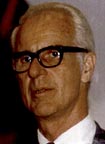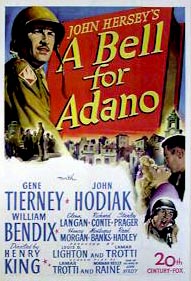|

























|
|
John
Hersey
"Neither the  eloquence
of Churchill nor the humaneness of Roosevelt, no Charter, no plan, no
hope, no treaty —
none of these can guarantee anything. Only men can guarantee, only the
behavior of men under pressure." eloquence
of Churchill nor the humaneness of Roosevelt, no Charter, no plan, no
hope, no treaty —
none of these can guarantee anything. Only men can guarantee, only the
behavior of men under pressure."
—
John
Hersey
Born:
June 17, 1914 Died: March 24, 1993
Birthplace: Tientsin, China
John Hersey was born on June 17, 1914 in Tientsin, China to missionaries
Roscoe and Grace Baird Hersey. He lived in Tientsin until he was ten years
old and then returned to the U. S. with his parents. Hersey attended Yale
and then went on to graduate study at Cambridge. He obtained a summer job
as a  secretary
for Sinclair Lewis in the summer of 1937, and, that fall, started work at
Time magazine. Two years later he was transferred to Time's Chungking
bureau. During World War II he covered the fighting in both Europe
(Sicily) and Asia (Guadalcanal), writing articles for Time, Life, and The
New Yorker. Hersey's first article for The New Yorker was a piece about
John F. Kennedy and the PT-109 rescue, which was later reprinted in
Reader's Digest. secretary
for Sinclair Lewis in the summer of 1937, and, that fall, started work at
Time magazine. Two years later he was transferred to Time's Chungking
bureau. During World War II he covered the fighting in both Europe
(Sicily) and Asia (Guadalcanal), writing articles for Time, Life, and The
New Yorker. Hersey's first article for The New Yorker was a piece about
John F. Kennedy and the PT-109 rescue, which was later reprinted in
Reader's Digest.
Hersey's first book, Men on Bataan (1942) was a
patriotic look at General Douglas MacArthur and his troops in the Pacific
at the beginning of the second World War. His second book, Into the Valley
(1943), described the fighting at Guadalcanal from the perspective of the
soldiers. At Guadalcanal, Hersey had become a participant rather than just
a reporter. The unit he was accompanying came under heavy fire and
suffered many casualties; Hersey was pressed into service as a stretcher
bearer and was later commended by the Navy for his assistance in aiding
the wounded.
Hersey was subsequently transferred to the
Mediterranean Theater, where he reported on the Allies' invasion and
occupation of Sicily. He won the Pulitzer Prize for his first novel, A
Bell for Adano (1944), a fictionalized account of the occupation
government in a small Italian town. (The New York Times listed his
Pulitzer on the same front page of its May 8, 1945 edition that announced
the end of the war in Europe.)
In 1944-45, Hersey was posted in Moscow by Time,
but after the war in the Pacific ended he received a joint assignment to
cover China and Japan, with expenses shared by Time and The New Yorker.
—
Source:
Steve
Rothman
 The
Algiers Motel Incident The
Algiers Motel Incident
Antonietta
A Bell for Adano (Won the Pulitzer Prize in 1945.)
Blues
Hiroshima
Key West Tales
A Single Pebble
The Wall
Life Sketches
The Call
"On August 6, 1945, Hiroshima was destroyed by the first atom bomb
ever dropped on a city. This book, John Hersey's journalistic
masterpiece, tells what happened on that day. Told through the memories
of survivors, this timeless, powerful and compassionate document has
become a classic "that stirs the  conscience
of humanity" conscience
of humanity"
—
The
New York Times
"One of the great classics of the war."
—
The
New Republic
"Hersey best conveys the horror of the day by sticking to concrete
details, rendering events in their spare, awful reality. Reading in
gruffly emotive terms is veteran actor and activist Asner. He's
unflinching throughout, recounting Hersey's words with sobering
conviction and passion."
—
Publishers
Weekly
"Nothing can be said about this book that can equal what the book
has to say. It speaks for itself, and in an unforgettable way, for
humanity."
—
The
New York Times
 Click
here to listen to a preview of Hiroshima (RealAudio format) Click
here to listen to a preview of Hiroshima (RealAudio format)
Go
back to
The 'Old' New Journalists
main page
 |
|